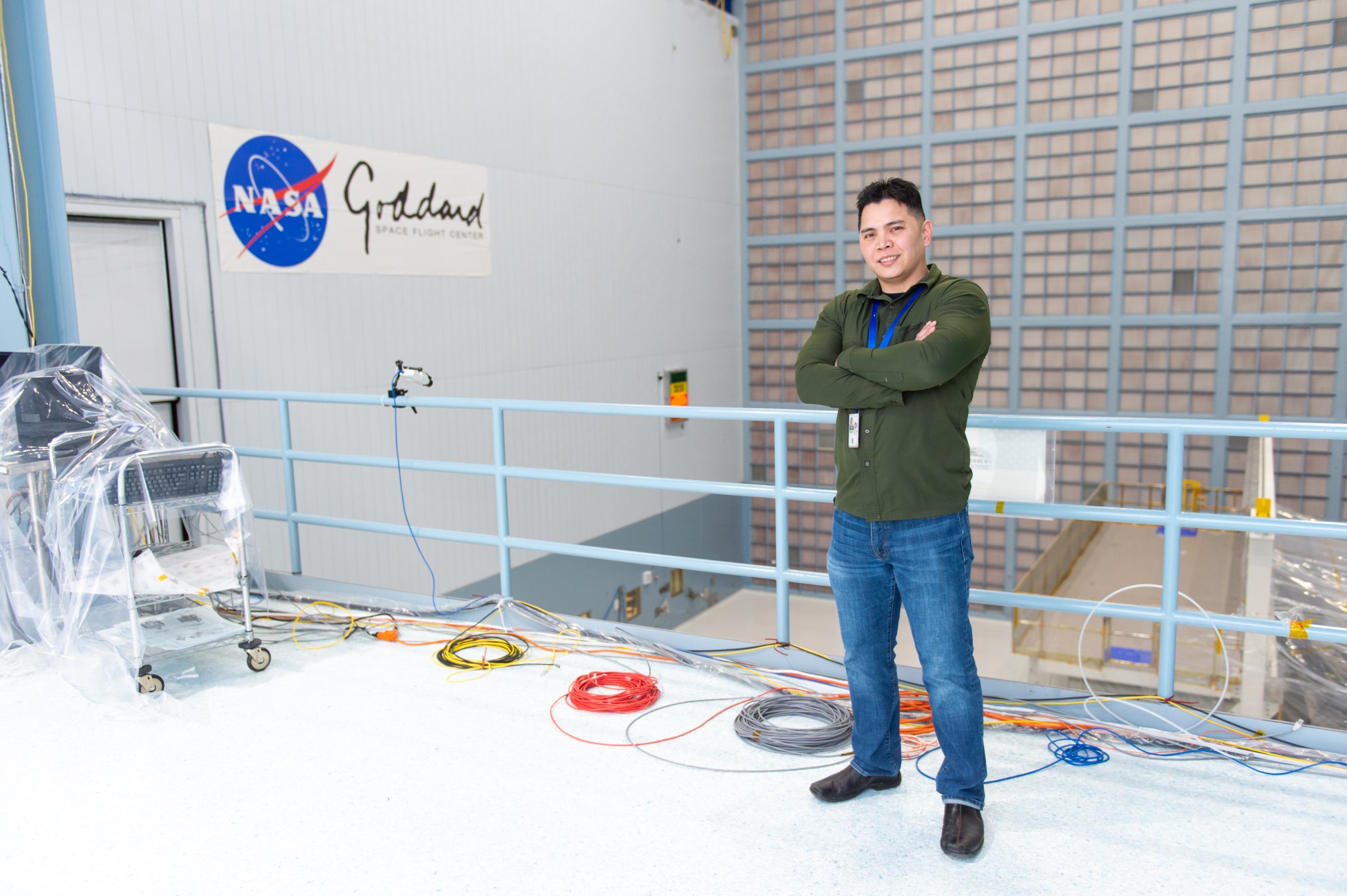Name: Vincent Cecilio
Title: Mechanical Engineer
Organization: Code 549, Environmental Testing and Integration Branch, Engineering and Technology Directorate
What do you do and what is most interesting about your role here at Goddard? How do you help support Goddard’s mission?
I am the lead HVAC engineer for the Integration and Test (I&T) Complex. This means that anything that involves moving air, heating air and cooling air is under my job description. My main priority is the clean rooms, including the Spacecraft Systems Development and Integration Facility (SSDIF), one of the largest class-10,000 clean rooms in the world. SSDIF has to be very clean because it is where we assemble sensitive instruments and spacecraft. Class-10,000 means within one cubic foot, we are only allowed up to 10,000 particles a half-micron in size. [Editor’s note: For a sense of scale, a human blood cell is about 5 microns in diameter; a cubic foot of normal ambient air may contain millions of particles of this size.]
How many clean rooms are at Goddard? What does it take to keep them clean?
Goddard has many clean rooms. However, I am responsible for the major clean rooms at the I&T Complex. Including SSDIF, the I&T Complex has six major clean rooms.
There are two ways we keep them clean. One way is through our contamination control group and the other way is through our clean room systems equipment, for which I am responsible.
I maintain different types of clean room systems equipment. Some of the equipment keeps our clean rooms slightly pressurized so we blow contaminants out and do not let other contaminants in. Other equipment ensures lots of airflow, which will dilute any contamination generated. Just like the saying, “dilution is the solution to pollution.” We also maintain sufficient humidity to mitigate against electrostatic discharge, which can be generated just by people moving around. We also maintain a comfortable temperature for the occupants while staying within the limits associated with the instruments and spacecraft. Bunny suits, the name given to the full-body garments worn in clean rooms, can get hot!
How much time do you spend in the clean rooms?
Actually, not much because most of the equipment used to maintain the clean rooms is outside the clean rooms. We have extremely accurate instruments inside the clean rooms to monitor the environment, but sometimes I need to verify by going inside the clean rooms.
What is a typical day on the job like for you?
When I get to my desk in the morning, I log into the clean rooms control system to ensure that all the clean rooms are happy. If not, I will diagnose the problem and work with our maintenance group to build a solution. If there are no problems, I find ways to modernize the systems and make them better.
What if there is a problem in the middle of the night?
The clean rooms are monitored by an automated control system 24/7, 365. It doesn’t get any holidays. If the system detects any problem, it will page our talented on-call response team, our first responders who are available 24/7, 365. They are the EMTs for the clean rooms. They resolve most of the problems. They are incredibly proactive and are always one-step ahead of Murphy’s law.
In the rare cases when they cannot immediately fix the problem, I get a call in the middle of the night to offer support. If we cannot reconfigure the system and quickly resolve the problem, then we call management and notify missions.
Why did you become a mechanical engineer?
I was born and raised in Hawaii. My father is an orthopedic surgeon who really wanted me to become a doctor. Life took a turn and led me towards engineering. My older sister became an engineer and inspired me to walk down that path.
I got a B.S. in mechanical engineering from the University of Maryland, Baltimore County. My father calls me a “doctor of mechanical systems.” I love to tinker with cars. I always try to improve them even though in my earlier years I sometimes ended up breaking them.
If you could summarize your job in just a few words, what would they be?
Keep it clean.
How did you come to Goddard?
After graduation, I came to Goddard and began my work in the Facilities Management Division. In March 2017, I began my current job in the I&T Complex.
Is there something surprising about you that people do not generally know?
I enjoy 100-mile century bike rides. Century rides help keep me fit and always push me to my breaking point. Each time I do one, it gets harder. Century rides give me perspective. During every single ride, there always comes a point that pushes me to give up. But if I don’t give up, if I keep going, I always get to the finish line and remind myself of the value of perseverance. So far, I have never given up. I maintain my 10-speed, carbon fiber road bike too.
Is there a fictional character that embodies what you do and what you believe in?
Montgomery “Scotty” Scott, the chief engineer of the USS Enterprise on Star Trek, is someone I definitively relate to. He is always tinkering and repairing the Enterprise. His management, Captain Kirk, always asks him to do challenging tasks under challenging conditions. In the end, Scotty always finds a way to do it. He never gives up and always gives it “all he’s got.”
Is your own house super clean?
Our house is just like everyone else’s house. Both my wife and I keep it clean, but we are not neat freaks.
By Elizabeth M. Jarrell
NASA’s Goddard Space Flight Center





























